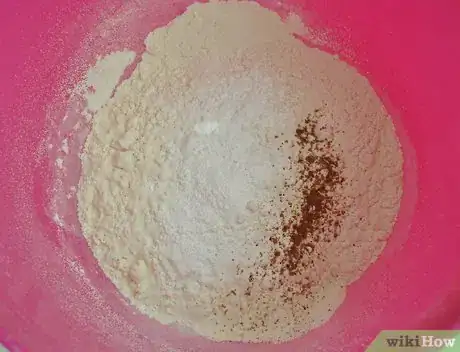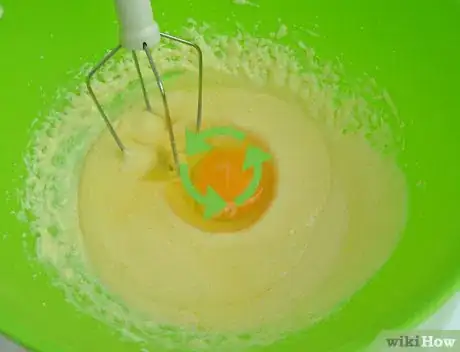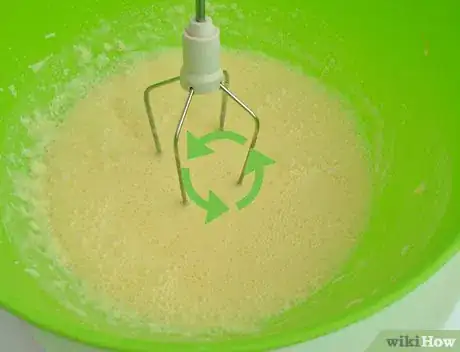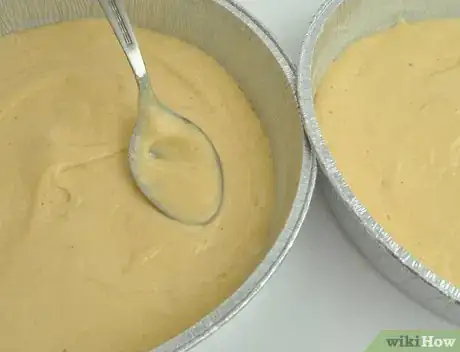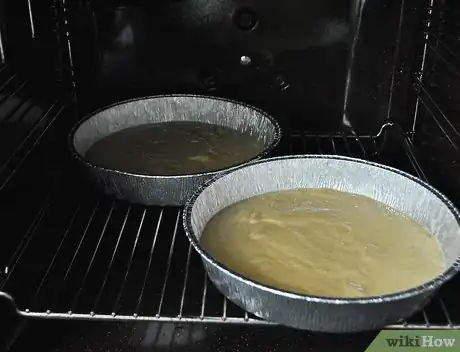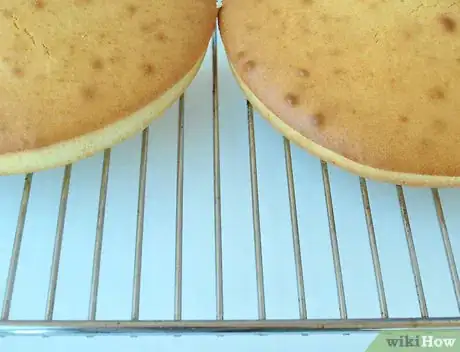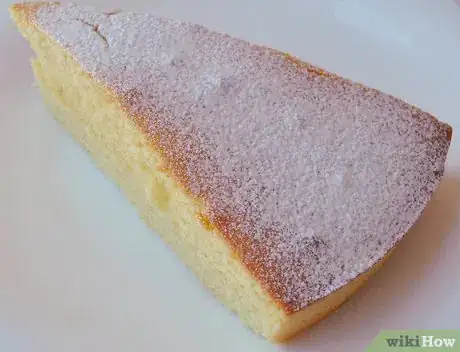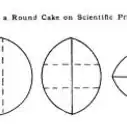This article was co-authored by wikiHow staff writer, Jessica Gibson. Jessica Gibson is a Writer and Editor who's been with wikiHow since 2014. After completing a year of art studies at the Emily Carr University in Vancouver, she graduated from Columbia College with a BA in History. Jessica also completed an MA in History from The University of Oregon in 2013.
This article has been viewed 203,289 times.
Learn more...
If you're looking for a rich cake that's easy to mix, make Nigerian cake. Cream butter and margarine with sugar until it's fluffy. Then beat in flour with baking powder along with milk. Spread the batter in 2 round pans and bake the cakes until they're golden brown. Nigerian cake is great when served simply, but you can frost and stack the cakes or cover them with fondant.
Ingredients
- 4 cups (520 g) plain flour[1]
- 2 cups (400 g) sugar
- 1 cup (226 g) unsalted butter, softened
- 1 cup (226 g) margarine
- 10 eggs at room temperature
- 1 tablespoon (15 ml) vanilla
- 4 tablespoons (26 g) powdered milk or 1⁄2 cup (120 ml) milk
- 1⁄2 cup (120 ml) water, if using powdered milk
- 1 tablespoon (14 g) baking powder
- 1/2 teaspoon (1 g) grated nutmeg, optional
Makes 2 round 8 or 9-in (20 or 23 cm) cakes
Steps
Mixing the Batter
-
1Preheat the oven to 350 °F (177 °C) and grease 2 round pans. You can use two 8 or 9-in (20 or 23 cm) cake pans. Butter and flour the pans or spray them with baking spray.
- To make it even easier to remove the cakes, consider lining the pans with parchment paper.
-
2Dissolve the powdered milk in the water. Measure 4 tablespoons (26 g) of powdered milk into a bowl and pour in 1⁄2 cup (120 ml) of water. Whisk or stir until the powdered milk is completely dissolved.
- If you'd like, use 1⁄2 cup (120 ml) of liquid milk instead of reconstituting the powdered milk.
Advertisement -
3Whisk the flour, baking powder, and nutmeg together in a separate bowl. Put 4 cups (520 g) of plain flour into a large bowl and add 1 tablespoon (14 g) of baking powder. If you'd like the cake to be lightly spiced, add 1/2 teaspoon (1 g) of grated nutmeg.
- Whisk the dry ingredients for about 30 seconds so that they are fully combined.
-
4Cream the butter, margarine, and sugar for 5 to 10 minutes. Place 1 cup (226 g) of softened unsalted butter, 1 cup (226 g) of margarine, and 2 cups (400 g) of sugar into a large mixing bowl. Use an electric or stand mixer to beat them together on medium speed.
-
5Beat in 10 eggs 1 at a time on medium speed. Keep the mixer running while you add 1 egg at a time to the creamed mixture. Once the egg is incorporated, add the next egg. Continue beating them in until you've added a total of 10 eggs.
- Room temperature eggs will blend into the batter the best. If they're cold the batter may separate, but it will come together again when you add the dry ingredients.
-
6Beat the batter for 2 minutes at medium-high speed and add the vanilla. Turn the mixer up and beat the batter so that it becomes pale. Then add 1 tablespoon (15 ml) of vanilla and beat it until it's incorporated.
-
7Alternate adding the dry mixture and the milk. Turn the mixer to low and beat in about 1/3 of the dry mix. Then beat in half of the milk before you add another 1/3 of the dry mix. Beat in the rest of the milk and then the rest of the flour. Stop beating as soon as the last of the dry mix is incorporated.
- It's fine if there are a few lumps in the cake batter.
- Over beating the batter will make the cake tough and dense.
Baking the Cakes
-
1Divide the cake batter between the 2 prepared pans. Spoon half of the batter into 1 of the greased cake pans and spread the rest of the batter in the other cake pan. Use the back of the spoon to evenly spread the tops.
-
2Bake the Nigerian cake in a preheated oven (300ºF) for 1 hour, or until the cake is springy to the touch.[4] Put both pans in the oven and bake them until they become golden brown and begin to pull away from the side of the pan.
- To test if the cakes are done, insert a cake tester or skewer into the center. The tester should come out clean. If it doesn't, bake the cake for 3 to 5 more minutes and check again.
-
3Cool the cakes and remove them from the pans. Take the cakes out of the oven and set them on a wire rack to cool. Once they're completely cooled down, turn them out and put them onto the wire rack.
-
4Stack and frost the cakes if you want a layer cake. Spread vanilla buttercream on 1 of the cakes and place the other cake on top. Spread more frosting on the top and sides.
- You can also spread rolled fondant on the top for an extra special look.
-
5Serve the Nigerian cake. If you don't want to frost the cakes, you can sprinkle both cakes with sifted powdered sugar. Cut slices of cake and serve it along with soy milk, sugar cane juice, or kunnu aya.
- Cover and store leftover cake in an airtight container at room temperature for 1 to 2 days or in the refrigerator for up to 1 week.
Community Q&A
-
QuestionHow can icing sugar be sprayed on the cake?
 Community AnswerA sieve can be used to evenly distribute the icing sugar onto the cake. Trying to sprinkle with other tools won't give you the same evenness.
Community AnswerA sieve can be used to evenly distribute the icing sugar onto the cake. Trying to sprinkle with other tools won't give you the same evenness. -
QuestionHow do I decorate the cake?This is a simple cake that is traditionally undecorated. If you wish to serve authentic Nigerian cake, following the steps in the regarding decorating and serving to cake. If you're not bothered about authenticity, decorate the cake however you wish. Spread whipped cream across the top of the cake, put icing or frosting on the cake or cover it in melted or crushed chocolate.
Things You'll Need
- Measuring cups and spoons
- Bowls
- Spoons
- Electric mixer with beater attachment
- Baking spray
- Parchment paper, optional
- Cake tester or skewer
- 2 round 8 or 9-in (20 or 23 cm) cake pans
- Wire racks
References
About This Article
If you want to make an easy, rich dessert, try a Nigerian cake. Start by preheating your oven to 350 degrees Fahrenheit and greasing 2 round pans. Next, dissolve powdered milk in water and set it aside. In another bowl, whisk flour, baking powder, and nutmeg together. Then, in a large mixing bowl, cream butter, margarine, and sugar for 5 to 10 minutes. Beat 10 eggs into the mixture, 1 at a time, and add vanilla at the end. Slowly alternate adding the dry mixture and the milk into the large mixing bowl until all of the ingredients are incorporated. Divide the batter between the 2 pans, then bake then for 50 minutes. To learn how to stack and frost your Nigerian cake, keep reading!


